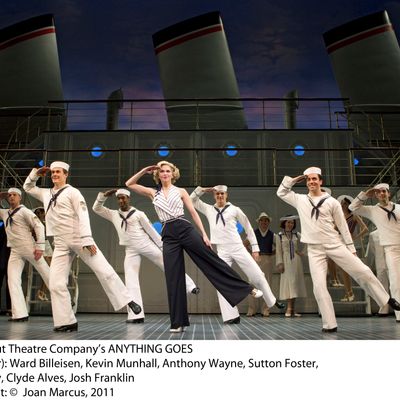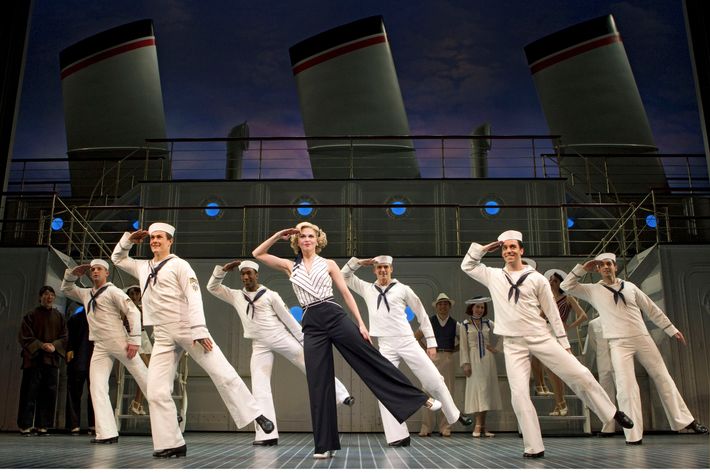

Anything Goes, Cole Porter’s ship of dreams, rhyme-schemes, carnal wit, and bubbly irreverence, is back in port, just in time to catch the tail of another financial crisis. (Its other two Broadway incarnations opened in the shadows of the Great Depression and Black Monday, respectively. Is Ben Bernanke a theatergoer? Maybe he ought to be keeping an eye on this show.) At the helm this time is Kathleen Marshall, whose sure and unfussy hand is even steadier here than it was on the tiller of The Pajama Game. This show (with its ‘62 and ‘87 rewrites and song additions) ain’t broke, and she clearly has no urge to try fixing it. There isn’t anything in Anything Goes that couldn’t have been executed seventy-something years ago with the same grace and facility, and for any lover of live musical theater, that’s enormously encouraging. Massive tri-level tap formations, old fashioned vaudeville bawdry, and daffy costume-switches still do the trick, and songs like “You’re the Top,” “It’s De-lovely,” and “I Get a Kick out of You” — sung by talents the size of Sutton Foster, Joel Grey, Laura Osnes, and Colin Donnell — still send little meteoric thrills streaking across our field of vision for days to come.
Which is, after all, what it’s designed to do. A what-me-worry musical toy box from the dark days of 1934, Anything Goes follows the crisscrossing nautical adventures of cabaret star Reno Sweeney (Foster); her platonic stowaway pal Billy Crocker (Donnell); and Billy’s intended, Hope Harcourt (Laura Osnes), a high-society girl with responsibilities that veto her heart. Her feelings for Billy aside, she’s engaged to a boneless Brit noodle named Lord Evelyn Oakleigh (played by the wonderful Adam Godley, comic timing on loan from Peter Sellers, body by Gumby). Along for the ride are a harmless mob underling named Moonface Martin (Grey) and his absent boss’s slatternly moll Erma (the fabulous Jessica Stone, who walks away with the show not once, not twice, but thrice). The story — Billy, with Reno’s reluctant help, must evade the ship’s authorities and get Hope to break her engagement to Evelyn before the S.S. American docks in Bristol — is a floss of farcical happenstance that would hardly support a video game; but it’s a perfect egg carton to hold Porter’s cork-popping songs. (More have been stuffed in over the years: “It’s De-Lovely,” for example, wasn’t added until the sixties.)
This is, in other words, a fun-machine, and it’s got precious few bugs. Watching the 78-year-old Grey onstage, in anything, is at this point a privilege not to be missed: To play Moon, he trades his usual light-footed prance for a Runyonesque duck walk. Watching him squire a spotlight in the one-man duet “Be Like the Bluebird” mashes all your nostalgia buttons at once: The days when one man and an azure patch of light could hold a thousand souls at rapt attention are, thankfully, still with us. Donnell — best described as Don Draper from the waist up, Fred Astaire from the waist down — is a born leading man, of whom we’ll be seeing a lot more, I imagine. As his beloved, Laura Osnes sells, and sings the daylights out of, a role we’re more or less predisposed not to like. Naturally, we’d rather see Billy end up with Reno; the fact that Anything Goes denies us this one key indulgence is one of its most intriguing features, and its only narrative gamble. And speaking of gambles: What about Reno, anyway? Namely, what’s sweet little Sutton Foster doing, playing her?
We generally expect bombshells to explode, especially bewigged brass-blonde ones. Diva-next-door Sutton Foster politely declines. Slipping into the iconic heels of Reno Sweeney — a roof-rattler role defined by the iron-piped likes of Ethel Merman and Patti Lupone — Foster takes a gentler, more detached approach: Her take on I’ve-been-burned-before isn’t so-I’ll-burn-down-the-theater-first. Instead of pedaling against her team-player instincts (a dispensation granted outright to all Renos) she gives us something rarely seen: a Reno who’s a functional part of the ensemble. It takes a bit of getting used to, this twinkling where we’re expecting blinding phosphorescence. On her watch, Gabriel doesn’t blow quite as hard as he has in the past. But that’s not to say she doesn’t command the follow-spot with a flick of her amused eyebrow. This Reno, and maybe Foster herself, isn’t afraid to be a tad uncomfortable playing something she’s not: She’s not made of brass and doesn’t try to be, and she doesn’t feel compelled to kick every burnished quip through the goalposts. (Though her delivery is unerringly solid: she’s a Swiss watch with a swing hand.) In a show about pretense and hypocrisy, if it’s about anything (and let’s not fool ourselves: Anything Goes isn’t about much), Foster is the most genuine merchandise on deck. Wry, mischievous, and goofy under her peroxide, that sly smile curling up one side of her mouth, she never once seems to be trying to hit the high-water belt mark that’s chalked on the back wall of the Sondheim. (At this point, I suppose it belongs to Paul Reubens.) What’s the world coming to? In olden days insane vibrato would set all our hearts staccato but now, God knows: Sutton just glows.
At the Roundabout’s Stephen Sondheim Theatre, 124 West 43rd Street.




